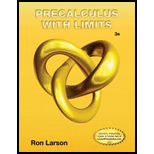
Concept explainers
To find : all the zeros of the function
Answer to Problem 102E
The zeros of the function are: x=23 ; √5 i ; −√5 i
Explanation of Solution
Given information: f(x)=3x3−2x2+15x−10
Concept Involved:
Synthetic Division (for a Cubic Polynomial):To divide ax3 + bx2 + cx + d by x−k , use this pattern.
| k|Coefficient of dividend︷ abcd↓ka↓↓↓_ ↗↗↗ a ︸Coefficient of quotient r←Remainder | In case when we have a polynomial with a missing term, insert placeholders with zero coefficients for missing powers of the variable. Vertical pattern: Add terms in columns Diagonal pattern: Multiply results by k. This algorithm for synthetic division works only for divisors of the form x - k. Remember that x+k =x−(−k) . |
The Division Algorithm: If f(x) and d(x) are polynomials such that d(x)≠0 , and the degree of d(x) isless than or equal to the degree of f(x) , then there exist unique polynomials q(x) and r(x) such that
f(x)↑Dividend = d(x)↑Divisor⋅q(x)↑Quotient +r(x)↑Remainder
…where r(x)=0 or the degree of r(x) is less than the degree of d(x) .
If theremainder r(x) is zero, then d(x) divides evenly into f(x) and k can be called as zero of the polynomial.
Calculation:
To find the zeros of the polynomial set the function equal to zero f(x)=0
3x3−2x2+15x−10=0
Factor the GCF of first two term and GCF of last two terms
x2(3x−2)+5(3x−2)=0
Factor the common binomial in the left side of the equation
(3x−2)(x2+5)=0
We need to set each factor equal to zero using the zero factor property which states that:
“If ab=0 , then a=0 or b=0 .”
x2+5=0 ▸1st equation
3x−2=0 ▸2nd equation
Solve the 1st equation x2+5=0
- By subtracting 5 on both sides, then
- By Splitting the number inside the square root in the right side of the equation, then
- By taking square root on both sides, then
- By simplifying square root on both sides of the equation, and then
- By replacing i for √−1
x2+5−5=0−5
x2=−5
√x2=√−5
√x2=√−1⋅√5
x =√−1⋅±√5
x=±√5 i
Solving the 2nd equation 3x−2=0
- By adding 2 on both sides, then
- By simplifying the equation on both sides, then
- By dividing 3 on both sides, and then
- By simplifying fraction on both sides of the equation
3x−2+2=0+2
3x=2
3x3=23
x=23
Conclusion:
The zeros of the given function f(x)=3x3−2x2+15x−10 are: x=23 ; √5 i ; −√5 i
Chapter 2 Solutions
Precalculus with Limits
- quick solve thisarrow_forwardquick solve thisarrow_forwardThis table displays the current in equal intervals. Time t/ms 05 10 15 20 25 30 Current i/A 0 4.8 9.1 12.7 8.8 3.5 0 The formula for the charge as follows: 30x10-3 q 0 i dt Use formula to solve the current at 30ms using both the trapezoidal rule and Simpson's rule showing all steps and workingarrow_forward
 Calculus: Early TranscendentalsCalculusISBN:9781285741550Author:James StewartPublisher:Cengage Learning
Calculus: Early TranscendentalsCalculusISBN:9781285741550Author:James StewartPublisher:Cengage Learning Thomas' Calculus (14th Edition)CalculusISBN:9780134438986Author:Joel R. Hass, Christopher E. Heil, Maurice D. WeirPublisher:PEARSON
Thomas' Calculus (14th Edition)CalculusISBN:9780134438986Author:Joel R. Hass, Christopher E. Heil, Maurice D. WeirPublisher:PEARSON Calculus: Early Transcendentals (3rd Edition)CalculusISBN:9780134763644Author:William L. Briggs, Lyle Cochran, Bernard Gillett, Eric SchulzPublisher:PEARSON
Calculus: Early Transcendentals (3rd Edition)CalculusISBN:9780134763644Author:William L. Briggs, Lyle Cochran, Bernard Gillett, Eric SchulzPublisher:PEARSON Calculus: Early TranscendentalsCalculusISBN:9781319050740Author:Jon Rogawski, Colin Adams, Robert FranzosaPublisher:W. H. Freeman
Calculus: Early TranscendentalsCalculusISBN:9781319050740Author:Jon Rogawski, Colin Adams, Robert FranzosaPublisher:W. H. Freeman
 Calculus: Early Transcendental FunctionsCalculusISBN:9781337552516Author:Ron Larson, Bruce H. EdwardsPublisher:Cengage Learning
Calculus: Early Transcendental FunctionsCalculusISBN:9781337552516Author:Ron Larson, Bruce H. EdwardsPublisher:Cengage Learning





